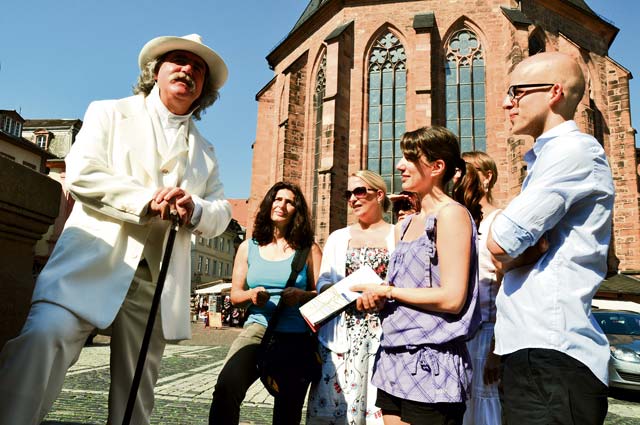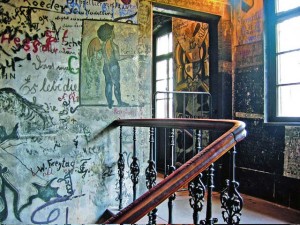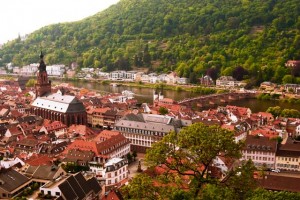
Mark Twain impersonator and tour guide Klaus Mombrei leads visitors to sites around Heidelberg during “In the Footsteps of Mark Twain.”
Wherever Mark Twain trod, his fans are sure to follow.
They trek to the American author’s homes in Hannibal, Mo., and Hartford, Conn. They cruise along the great Mississippi River by steamboat. Above all, they travel by imagination, soaking up his written word.
But fans of Twain’s wit and wisdom might be surprised to find out that a significant part of literary history played out in Heidelberg, where the author of the “Adventures of Huckleberry Finn” and “The Adventures of Tom Sawyer” lived for three months in 1878.

Visit the University of Heidelberg’s “Studentenkarzer,” a student prison, during the “In the Footsteps of Mark Twain” tour.
As the story goes, Twain (real name Samuel Clemens) arrived with his family intending to stay just one day.
“He loved it here, and that’s no surprise,” said Irene Feilhauer, communications manager with Heidelberg Marketing. “He’s one of many who have stopped here and decided to stay longer. Everybody seems to make a connection.”
Twain’s travels abroad that year — including Switzerland, France and Italy — were part fun, part business. He made a salary conducting research and lecturing at universities. A collection of observations and fictional stories about the trip became his second travel novel, “A Tramp Abroad,” published in 1880. The first part of the book describes his time in Heidelberg and how he fell under the city’s spell.
“One thinks Heidelberg by day — with its surroundings — is the last possibility of the beautiful,” Twain wrote. “But when he sees Heidelberg by night, a fallen Milky Way, with that glittering railway constellation pinned to the border, he requires time to consider upon the verdict.”
No one is sure why Twain spent so much time in Heidelberg, wrote Werner Pieper in his book, “Mark Twain’s Guide to Heidelberg.”
Maybe the ties to academia — it’s home to the oldest college in Germany — attracted Twain. Maybe the castle dazzled him from its perch on the hillside above the Neckar River. Maybe, some have hypothesized, because “Heidelberg” comes from the German word “huckleberry mountain” and, at that time, Twain was struggling to complete several novels, including the “Adventures of Huckleberry Finn.”
“Maybe he was prompted by old dreams from the times he was passing Heidelberg, Miss., while working on the steamships,” Pieper mused. “Did he plan to stay here, or did he and his family just fall in love with this city?”
Hoping to break his writer’s block, Twain rented a secluded studio on “Königstuhl” (king’s seat) mountain and wrote every day hoping to finish his novels. Twain also spent a lot of time traveling on or along the river, and the experience triggered his
fantasy about a mythical raft voyage. He first penned a fictional account for “A Tramp Abroad.” Later, he used the same idea to write the story of Huck and Jim’s rafting trip in Chapter 16 of the “Adventures of Huckleberry Finn” and wrapped up the novel.

The City of Heidelberg is seen from Heidelberg Castle. Mark Twain admired this view during his stay there for three months in 1878. He was impressed by the views of the city from the mountainside and the castle and described them in “A Tramp Abroad.”
Because so much remains the same a century later, it’s easy to visualize Twain, standing tall in his signature white suit, wandering the cobblestone streets of Heidelberg or smoking his pipe in a pub. In fact, you can read “A Tramp Abroad” online for free, and then retrace Twain’s sojourn in Heidelberg by yourself or with a group tour led by local Twain impersonator, Klaus Mombrei.
Although Mombrei does not consider himself a specialist on Twain, he said he “does know a little about what Heidelberg was like when he was here” and will entertain in costume.
Reserve a special group tour “In the Footsteps of Mark Twain,” led by Twain impersonator Klaus Mombrei by calling the Heidelberg Marketing office at 06221-5840223 or emailing guide@heidelberg-marketing.de. A free online copy of “A Tramp Abroad” can be found at: http://twain.thefreelibrary.com/Tramp-Abroad.
Sites detailed in “A Tramp Abroad” include:
• The Hotel Schrieder, where Twain laid his head at night (now the Crowne Plaza hotel, Kurfursten-Anlage 1)
• The Heidelberg Castle, where Twain explored the ruins and visited the Heidelberg Tun, a massive wine barrel in the cellar (Schlosshof 1).
• The hills above Heidelberg, where Twain enjoyed sweeping views of the town. He wrote, “I have never enjoyed a view, which had such a serene and satisfying charm about it as this one gives.”
• The University of Heidelberg’s “Studentenkarzer,” a students’ prison that operated from 1778 to 1914. Students were incarcerated for playing pranks on locals, disturbing the peace or excessive drinking. Twain visited the jail and described the graffiti on its walls (Augustinergasse 2).
• The Hotel Die Hirschgasse Heidelberg, a local tavern and hotel where Twain watched and documented a traditional fencing duel between several members of a student fraternity (Hirschgasse 3).
• The Zum Roten Ochsen, a traditional student pub built in 1703 and still in business today. Twain frequented this bar to spend time with the students (Hauptstrasse 217).
• The Dilsberg Castle, where Twain investigated a legend about a secret tunnel that connected the castle well to the outside world. Years later, a curious German-American found the tunnel after being lowered into the well. It’s now open to the public (Burghofweg, in Neckargemund).
• The summit of Konigstuhl Mountain (“King’s Seat”), near where Twain stayed later that summer in the Schloss Hotel (now closed) and established his writing studio. Ride the funicular railway to the top. It starts at the Kornmarkt in the city’s Altstadt section.







